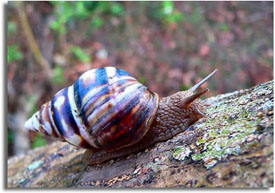 |
| Liguus Tree Snail - l. f. barbouri © |
One of these is a book titled "The Liguus Tree Snails of South Florida " written by Henry T Close From his writings I
learned not only how limited their range was but where and how to locate these last few small areas. " written by Henry T Close From his writings I
learned not only how limited their range was but where and how to locate these last few small areas.
He states that there were 59 color varieties
of Liguus Snails and it seems the only habitat in this country where they can survive is in extreme southern Florida.
Several of these varieties are now extinct and others are extremely
rare. They range in color and pattern from white to black, solid to banded,
dull to glossy. Vivid yellows, browns, blues, and greens are often
displayed as stripes, flames, and washes.
With Henrys book in one hand and my camera in the other I headed back to
see how many of these colorful snails I could find. I now knew that they
would be found in sub-tropical hardwood hammocks and they preferred Jamaica
dogwood and wild tamarind as well as poisonwood and pigeon plum trees. We
did well in locating them and managed to get some photos. The majority of
our find was located in the
Big Cypress Preserve. |